Vietnamese cuisine is known for its vibrant flavors and creative use of ingredients, and this omelette recipe is no exception. By combining the fluffy texture of the omelette with the tender and juicy crab meat, you’ll experience a delightful fusion of tastes and textures that will tantalize your taste buds.
Omelettes are often enjoyed as a quick and satisfying breakfast, a nourishing meal for lunch or dinner, or even as street food during bustling markets and festivals.
This step-by-step guide will help you create a delicious Vietnamese omelette with crab meat in no time. No fancy techniques or complicated ingredients required!
Key ingredients
Eggs
Undoubtedly the star of the dish, eggs are the foundation of any Vietnamese omelette. They provide the fluffy and light texture that is characteristic of a well-prepared omelette. Be sure to use fresh eggs for the best results.
Vietnamese fish sauce
A unique flavor enhancer, Vietnamese fish sauce adds depth and umami to the omelette. It is a staple ingredient in Vietnamese cuisine and can be found in many traditional recipes. The fish sauce infuses the omelette with a delightful savory taste that is synonymous with Vietnamese flavors.
Other essential ingredients
While eggs and fish sauce are the primary components, there are additional ingredients that can be included to elevate the flavor profile of your Vietnamese omelette. These may include finely chopped onions, garlic, shallots, scallions, or cilantro. The use of herbs and spices adds freshness and aromatic complexity to the dish.
Vietnamese omelette recipe
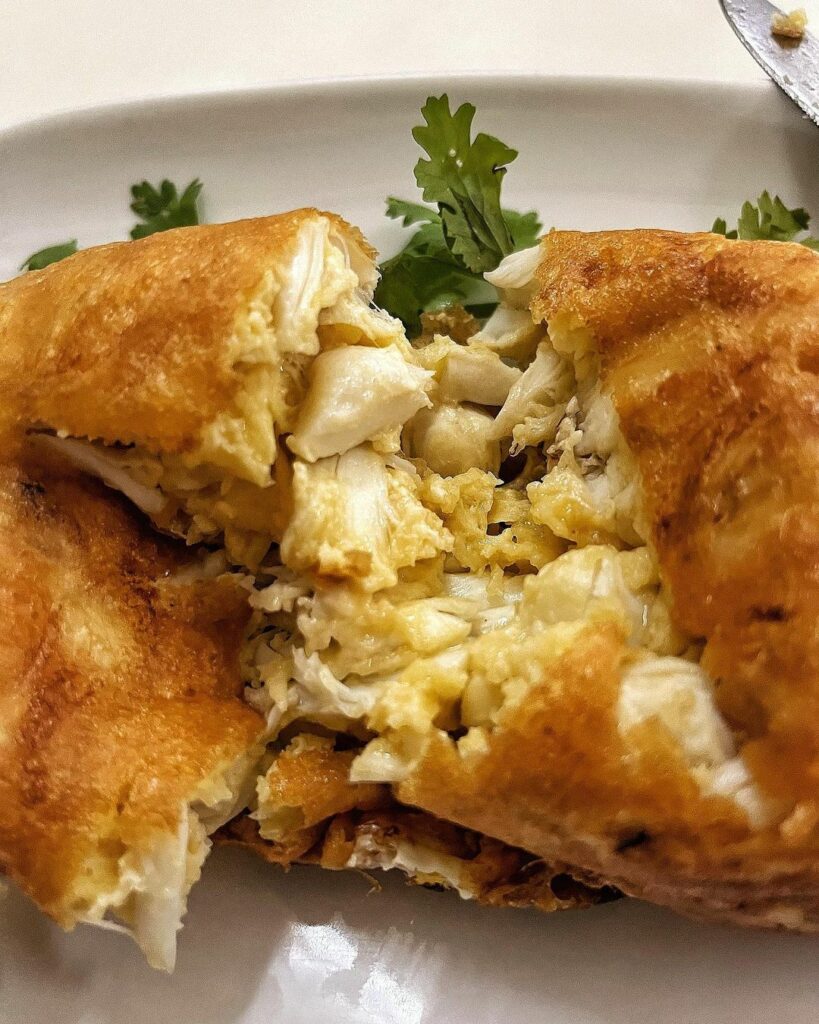
Indulge in the delectable flavors of a Vietnamese crab omelette, where the delicate sweetness of crab meat harmoniously combines with the light and fluffy texture of the omelette. This recipe showcases the artistry of Vietnamese cuisine, transforming simple ingredients into a mouthwatering masterpiece.
Cooking note
Here are some essential cooking notes to keep in mind while preparing this delicious Vietnamese omelette with crab meat
- Yield: 4 servings
- Prep Time: 10 minutes
- Cook Time: 15 minutes
- Total Time: 25 minutes
- Course: Main Dish
- Cuisine: Vietnamese
- Equipment: Large mixing bowl, whisk, non-stick frying pan or skillet, spatula
Trung chien ingredients

To create the tantalizing flavors of a Vietnamese crab omelette, gather the following ingredients:
- Eggs: 4 large eggs (or equivalent to your desired serving size)
- Vietnamese Fish Sauce: 1 tablespoon
- Crab Meat: 1 cup of fresh or canned crab meat (ensure it is cooked and properly cleaned)
- Cooking Oil: 1-2 tablespoons for frying the omelette
- Optional Additions: You can further enhance the flavors by including finely chopped onions, garlic, shallots, scallions, or cilantro.
How to make Vietnamese omelette with crab?
Preparing crab meat
If you’re using fresh crab meat, follow these steps to prepare it for your Vietnamese crab omelette:
- Begin by ensuring that the crab meat is cooked and properly cleaned. If you’re using whole crabs, cook them according to your preferred method (boiling, steaming, etc.) until the meat is fully cooked and tender.
- Once the crabs are cooked, allow them to cool slightly before extracting the meat. Gently crack open the crab shells and remove the meat, taking care to discard any shells or cartilage.
- After removing the meat, inspect it for any remaining shell fragments. Use your fingers or a small fork to carefully pick out any stray pieces, ensuring that the crab meat is clean and free of debris.
- If you’re using canned crab meat, drain and rinse it thoroughly to remove any excess brine or liquid. This step helps to eliminate any unwanted flavors or excessive saltiness.
Making Vietnamese crab omelette
- In a large mixing bowl, crack the eggs and whisk them until well beaten. Ensure the yolks and whites are fully combined.
- Add Vietnamese fish sauce to the beaten eggs and whisk again to incorporate the flavors. The fish sauce will enhance the overall taste of the omelette.
- Gently fold in the prepared crab meat, ensuring it is evenly distributed throughout the egg mixture. This will ensure that each bite contains a delightful combination of crab and egg.
- Heat 1-2 tablespoons of cooking oil in a non-stick frying pan or skillet over medium heat. Ensure the entire surface of the pan is coated with oil.
- Pour the egg and crab mixture into the heated pan, distributing it evenly to form a round or oval shape. Allow the mixture to spread out naturally.
- Cook the omelette for a few minutes until the edges start to set and the bottom becomes golden brown. Use a spatula to carefully lift the edges and peek underneath to check the color.
- Once the bottom is nicely browned, gently flip the omelette using the spatula. Cook for an additional 1-2 minutes until the other side is cooked through and golden brown.
- Transfer the cooked omelette to a serving plate and repeat the process if needed for any remaining egg mixture.
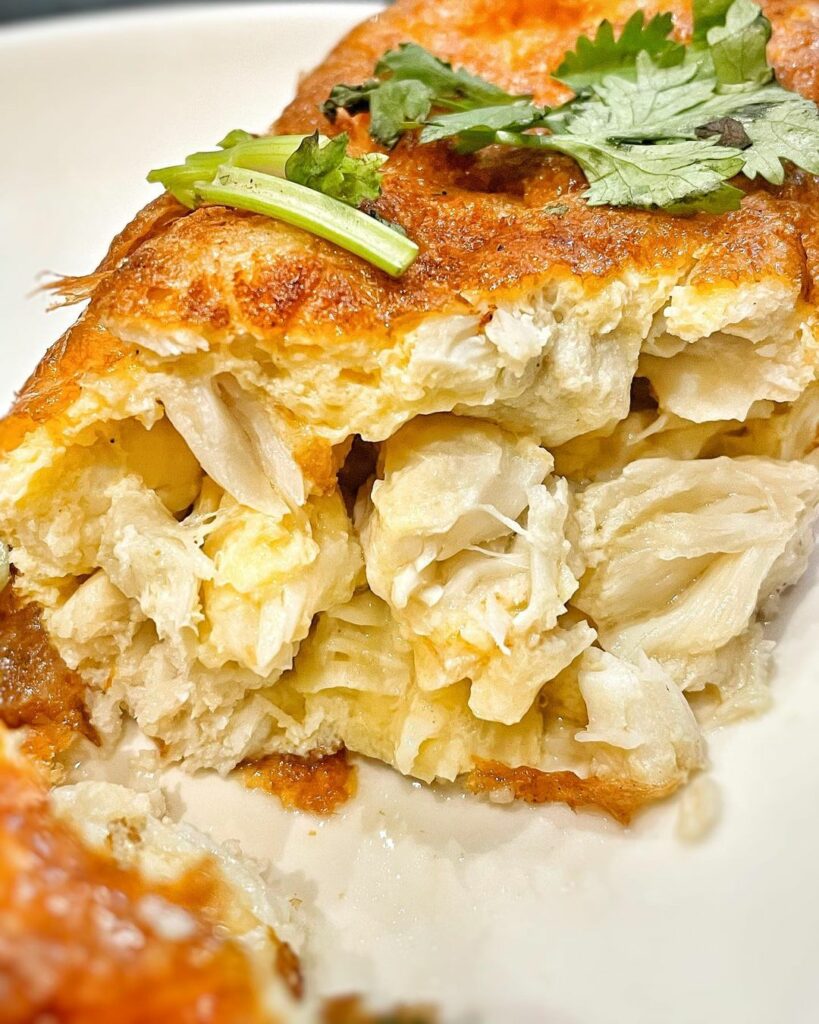
Vietnamese egg omelette tips
- Be sure to whisk the eggs thoroughly to achieve a fluffy texture.
- Avoid overcooking the omelette as it can become tough and rubbery.
- Use a non-stick frying pan or skillet to prevent the omelette from sticking.
- Choose fresh and high-quality crab meat to ensure maximum flavor and juiciness.
- Vietnamese fish sauce is a crucial ingredient that adds depth and umami to the dish. Use a good quality fish sauce for the best results.
- Don’t be afraid to experiment with additional ingredients and seasonings to create your own unique flavor profile.
- Serve the omelette hot with a side of steamed rice and some fresh herbs for an authentic Vietnamese meal experience.
Vietnamese style omelette variations
Vietnamese Rice Paper Omelette
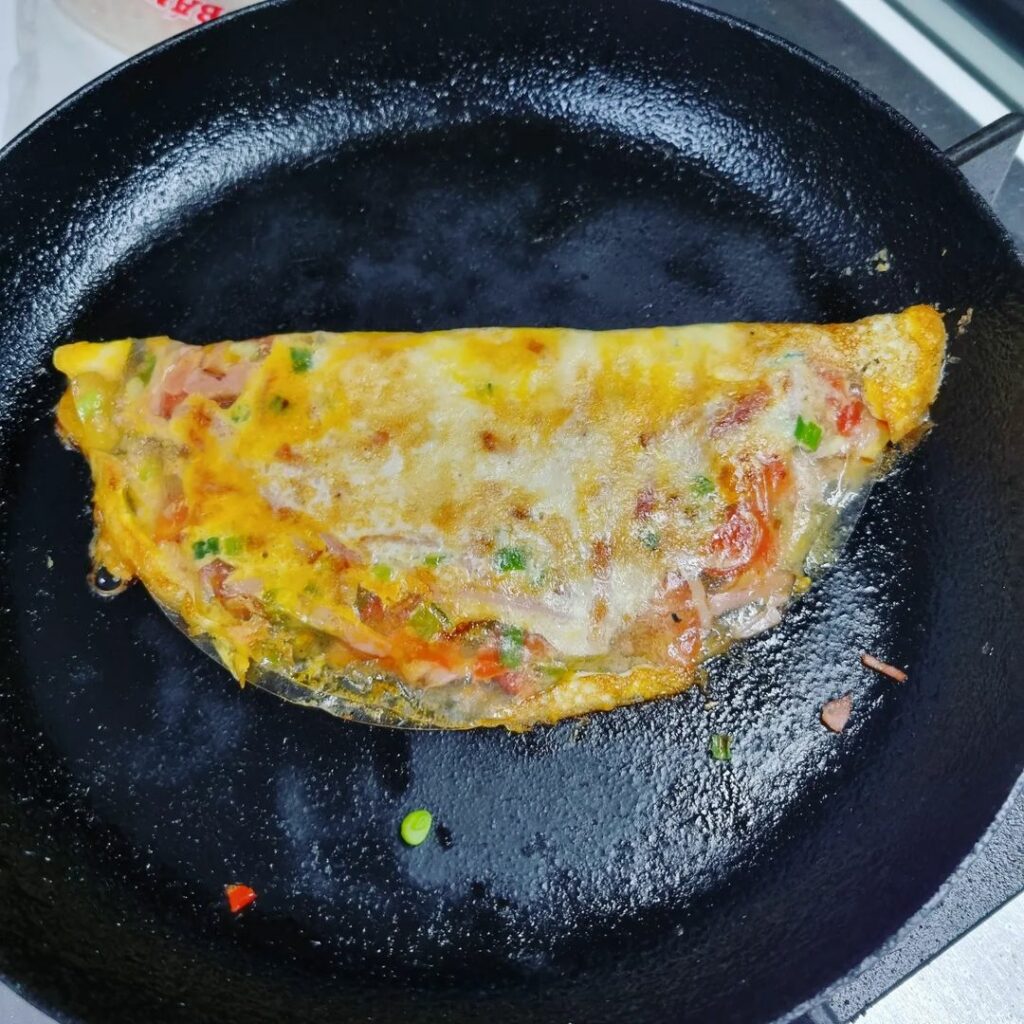
The Vietnamese Rice Paper Omelette is a delightful variation that offers a crispy, savory, and hearty twist to the traditional omelette.
It requires only 4 simple ingredients, making it an easy and quick dish to prepare. The main ingredient, rice paper, adds a unique texture to the omelette, providing a delicate crunch.
When cooked, the rice paper turns golden and crispy, enveloping the fluffy egg mixture inside. This variation is perfect for breakfast or brunch, offering a delightful combination of flavors and textures.
Trứng Chiên Thịt Băm (Minced Meat Omelette)
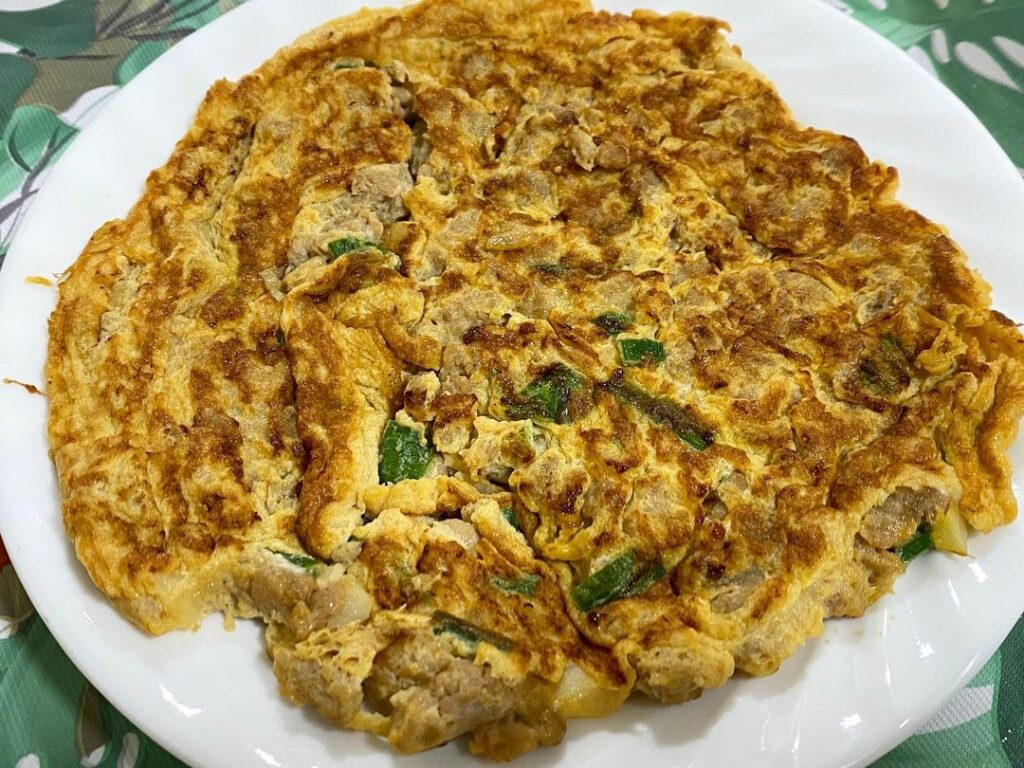
Trứng Chiên Thịt Băm is a Vietnamese omelette variation that features minced meat, typically pork or chicken, incorporated into the egg mixture.
The minced meat adds a savory and meaty flavor to the omelette, complementing the light and fluffy texture of the eggs. Additional ingredients such as onions, garlic, and seasonings can be included to enhance the taste profile.
This variation is a delicious and satisfying option that can be enjoyed as a standalone dish or served alongside rice for a complete meal.
Trứng Chiên Lạp Xưởng (Chinese Sausage Omelette)

Trứng Chiên Lạp Xưởng showcases the fusion of Vietnamese and Chinese flavors. This variation combines the classic Vietnamese omelette with the savory and slightly sweet taste of Chinese sausage (lạp xưởng).
The sausage is thinly sliced and incorporated into the egg mixture, infusing the omelette with its unique aroma and taste.
The combination of the juicy sausage and fluffy eggs creates a delightful harmony of flavors, making it a popular choice for breakfast or brunch.
Vietnamese Prawn Omelette
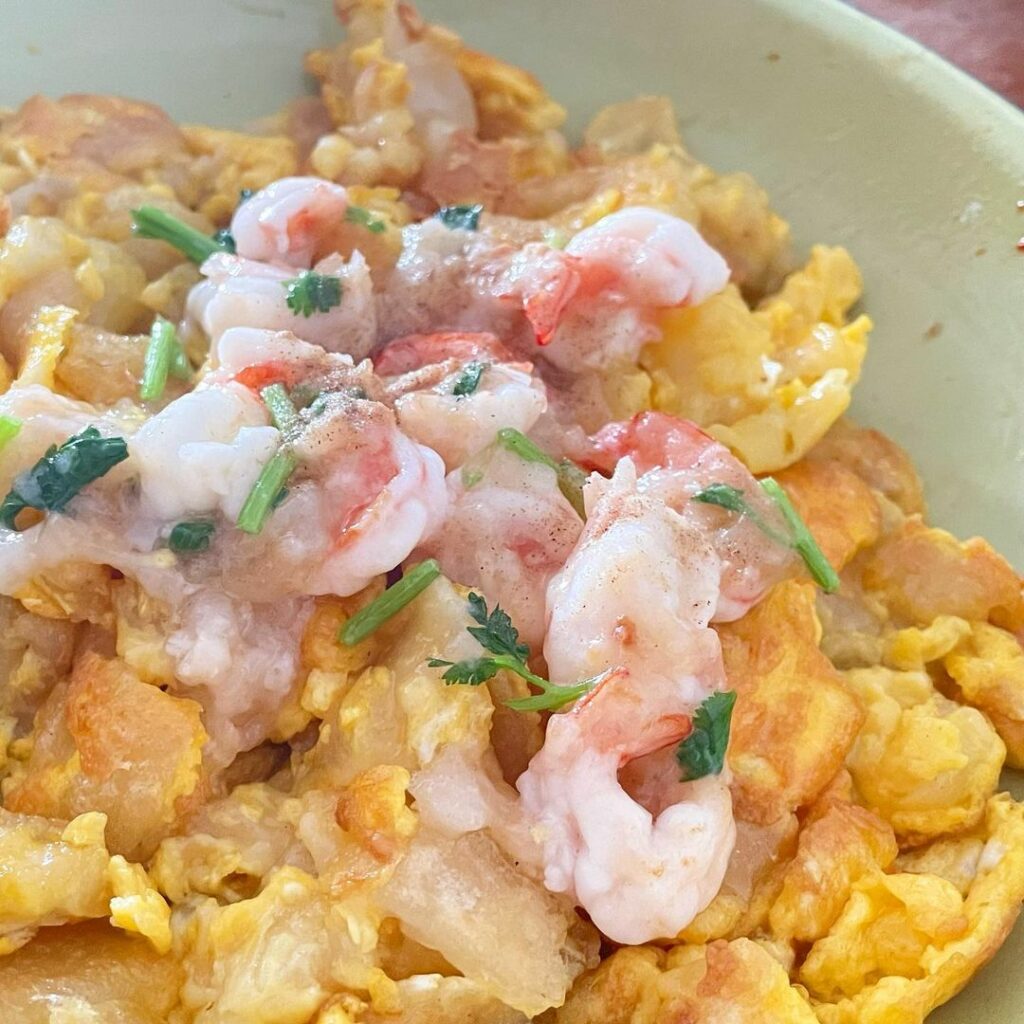
The Vietnamese Prawn Omelette offers a delightful seafood twist to the traditional omelette.
Fresh prawns are the star ingredient, providing a delicate and slightly sweet taste that pairs perfectly with the eggs. The prawns can be cooked and roughly chopped before being added to the egg mixture.
Trứng cút/ Trứng vịt chiên (Quail Egg/ Duck Egg Omelette)
The Vietnamese omelette recipe with crab meat can be further adapted to include variations such as “Trứng Cút Chiên” (Quail Egg Omelette) or “Trứng Vịt Chiên” (Duck Egg Omelette).
For a delightful twist, you can replace the regular chicken eggs with quail eggs or duck eggs to create unique flavor profiles. Quail eggs bring a delicate and slightly gamey taste to the omelette, while duck eggs offer a richer and creamier texture.
When using quail eggs, consider increasing the quantity to account for their smaller size. Duck eggs, on the other hand, may require a slightly longer cooking time due to their larger size and higher fat content.
Watch this video to know more about Vietnamese omelette
Vietnamese omelette vegetarian and vegan options
For those following a vegetarian or vegan lifestyle, there are wonderful alternatives to traditional egg-based Vietnamese omelettes.
Substitutes for eggs
Silken Tofu: Silken tofu is a popular option for creating a vegan omelette base. Its creamy texture and mild taste make it an excellent substitute for eggs. Simply blend or mash the tofu until smooth and use it as the base for your omelette mixture.
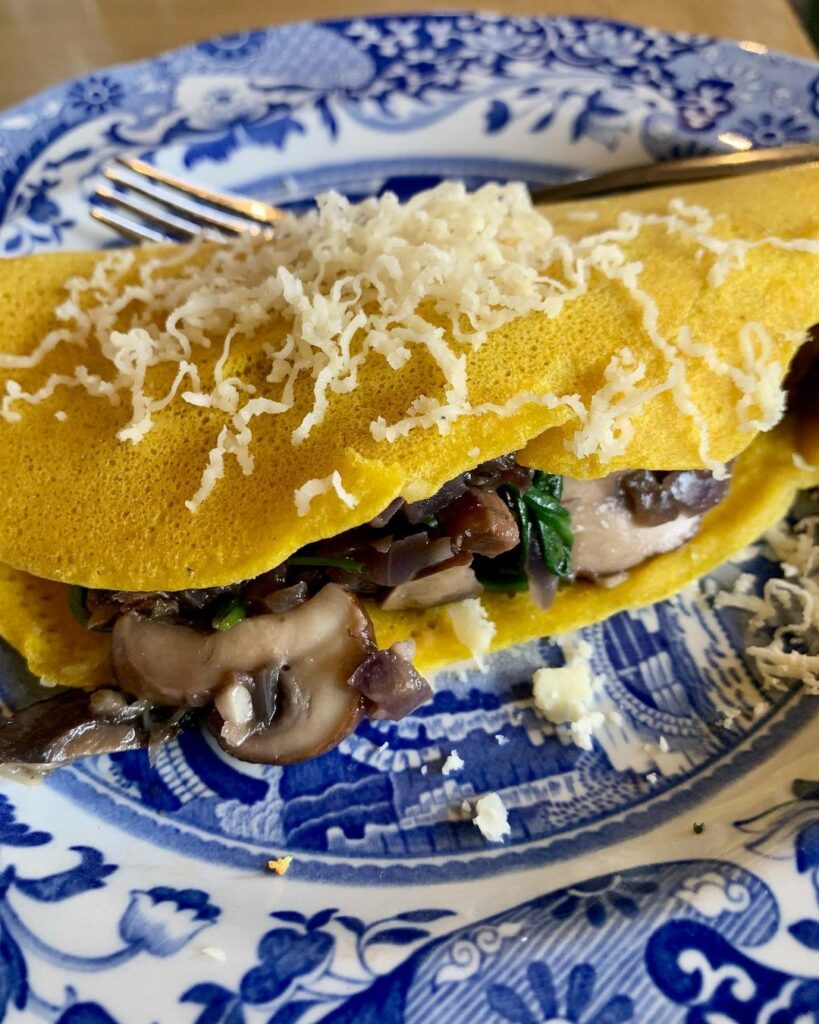
Chickpea Flour: Also known as gram flour or besan, chickpea flour can be mixed with water and seasonings to create an egg-like batter for omelettes. It adds a savory and slightly nutty flavor to the dish.
Plant-based Ingredients
Vegetables: Incorporate a variety of finely chopped vegetables such as bell peppers, onions, mushrooms, spinach, and tomatoes to add texture, color, and flavor to your vegetarian or vegan omelette. These ingredients can mimic the filling and enhance the overall taste experience.
Tofu Scramble: For a heartier alternative, crumble or dice firm tofu and sauté it with spices and seasonings to create a tofu scramble. This flavorful addition brings a satisfying protein element to your omelette.
Vegan Meat Substitutes: Explore plant-based meat alternatives, such as vegan sausage or vegan ham, to replicate the texture and taste of meat in your omelette. These options can add depth and variety to your dish.
How to serve Vietnamese omelette with crab meat?
Vietnamese omelette with crab meat is a versatile dish that can be enjoyed in various ways. Here are a few suggestions on how to serve and enhance the flavors of this delightful culinary creation:
As a standalone dish
Serve the Vietnamese omelette with crab meat as a standalone dish. The combination of the fluffy omelette and succulent crab meat provides a satisfying and flavorful meal on its own. Garnish with fresh herbs such as cilantro or Thai basil for an extra burst of freshness.
With a side of Vietnamese white rice
The fluffy omelette and succulent crab meat pair wonderfully with the simplicity and neutral flavor of rice. You can serve with white rice or microwaved brown rice. Or you can pair it with Com tam, Vietnamese fried rice.
Read also: How Much Rice Per Person?
With dipping sauce
Prepare a dipping sauce to accompany the omelette. A simple yet delicious option is a combination of fish sauce, lime juice, sugar, minced garlic, and chili for a sweet, tangy, and slightly spicy flavor profile. Dip each bite of the omelette into the sauce before savoring it, enhancing the taste and adding a delightful tang.
Rolled in lettuce wraps
Another serving suggestion is to roll portions of the Vietnamese omelette with crab meat in fresh lettuce leaves. Add some vermicelli noodles, bean sprouts, cucumber slices, and herbs such as mint or cilantro. Drizzle with a dipping sauce or a Vietnamese-style dressing for a refreshing and light meal.
Accompanied by pickled vegetables
Vietnamese cuisine often features pickled vegetables as a side dish to balance the flavors. Serve your omelette with pickled vegetables such as carrots, daikon radish, or pickled cucumbers. The tangy and crunchy pickles provide a delightful contrast to the rich flavors of the omelette.
With a side of fresh salad
Complement the Vietnamese omelette with a side salad made of mixed Vietnam vegetables, cherry tomatoes, thinly sliced onions, and a zesty vinaigrette. The crisp and refreshing salad adds freshness and lightness to the dish.
Health benefits of Vietnamese omelette
| Nutrient | Amount |
| Calories | 237 |
| Total Fat | 16.6g |
| Saturated Fat | 3.9g |
| Cholesterol | 373mg |
| Sodium | 1143mg |
| Total Carbohydrates | 3.3g |
| Dietary Fiber | 0.1g |
| Sugars | 0.9g |
| Protein | 18.8g |
| Vitamin D | 123IU |
| Calcium | 62mg |
| Iron | 2.3mg |
| Potassium | 221mg |
Vietnamese omelette in restaurants vs home cooking
| Aspect | Restaurants | Home Cooking |
| Ingredient Selection | May offer a variety of omelette options | Flexible to customize ingredients |
| Flavor Profiles | Culinary expertise in flavor balance | Personalized to taste preferences |
| Presentation | Artfully plated and visually appealing | Simple and homemade appearance |
| Cooking Techniques | Professional cooking methods employed | Varies based on individual cooking skills |
| Consistency | Consistent taste and texture | May vary depending on home cook’s skills |
| Portion Size | Standardized portions for menu items | Adjustable based on personal preference |
| Price | Typically higher due to restaurant costs | More cost-effective and budget-friendly |
| Dining Experience | Enjoyment of restaurant ambiance | Comfort and convenience of home |
When comparing Vietnamese omelettes in restaurants versus home cooking, there are notable differences. Restaurants often offer a wider range of omelette options and employ culinary expertise to create well-balanced flavors. The presentation in restaurants tends to be artfully plated, enhancing the dining experience.
In home cooking, there is flexibility to customize the ingredients and flavors of the omelette to personal preferences. The cooking techniques vary based on individual skills, and the appearance is more homemade and simple. Home cooking allows for adjustments in portion sizes and is often more cost-effective.
FAQs
How to store Vietnamese omelette?
After cooking, allow the trung chien to cool to room temperature. Store it in an airtight container in the refrigerator for up to three days.
How to reheat trung chien?
Reheating in the Oven:
To reheat the trung chien in the oven, preheat it to 350°F. Place the trung chien in an oven-safe dish and cover it with foil. Heat it in the oven for about 10-15 minutes, or until the internal temperature reaches 165°F.
Reheating on the Stove:
You can also reheat trung chien on the stove. Place the trung chien in a non-stick pan with a small amount of oil or butter. Heat it over medium heat until it is warmed through, stirring occasionally to prevent burning.
Reheating in the Microwave:
To reheat trung chien in the microwave, place it in a microwave-safe dish and cover it with a damp paper towel. Heat it for 30-second intervals, stirring occasionally, until it reaches the desired temperature.
What other omelettes are different from Vietnamese egg omelettes?
Other omelettes from around the world offer distinct flavors and ingredients compared to Vietnamese omelettes.
For example, the Spanish omelette, or “Tortilla Española,” features layers of thinly sliced potatoes and onions cooked in olive oil with beaten eggs, resulting in a hearty and satisfying dish.
The French omelette, known for its delicate and creamy texture, is typically made with just eggs, butter, and seasonings, creating a classic and elegant culinary experience.
Meanwhile, the Mexican omelette, or “Omelette con Queso,” incorporates ingredients like cheese, tomatoes, onions, and spices, resulting in a flavorful and vibrant dish.
These variations showcase the diversity of omelettes worldwide, each with its own unique twist and cultural influence.
Can I make a Vietnamese omelette ahead of time?
Yes, you can make a Vietnamese omelette ahead of time to save time and ensure convenience.
Are Vietnamese omelettes suitable for people with dietary restrictions?
Yes, Vietnamese omelettes can be suitable for people with dietary restrictions, depending on the specific restrictions and modifications made. By adjusting the ingredients and cooking techniques, Vietnamese omelettes can be adapted to accommodate various dietary needs, such as vegetarian or gluten-free diets.
How can I prevent the omelette from sticking to the pan?
Use a non-stick pan: Opt for a non-stick frying pan or skillet, which naturally reduces the chances of the omelette sticking to the surface.
Preheat the pan properly: Ensure that the pan is heated over medium heat before adding any ingredients. This allows the oil or cooking spray to evenly coat the surface, creating a non-stick barrier.
Oil or cooking spray: Apply a thin layer of cooking oil or use a cooking spray on the pan before pouring in the egg mixture. This further aids in creating a non-stick surface.
Allow proper cooking time: Give the omelette enough time to cook and set before attempting to flip or move it. Rushing the process may cause the omelette to break apart or stick to the pan.
Gently loosen the edges: Once the omelette starts to cook and set, use a spatula to gently loosen the edges from the pan. This will help ensure that the entire omelette is free from sticking.
Can I substitute the fish sauce with another ingredient?
Soy Sauce: Soy sauce can be used as a substitute for fish sauce in Vietnamese omelettes. However, keep in mind that soy sauce has a different flavor profile, so the taste of the omelette will be slightly altered.
Tamari Sauce: Tamari sauce is a gluten-free alternative to soy sauce and can be used as a substitute for fish sauce. It has a similar savory taste and can provide depth of flavor to the omelette.
Coconut Aminos: Coconut aminos is a popular substitute for soy sauce and fish sauce, especially for those following a soy-free or gluten-free diet. It has a milder and slightly sweet flavor, so adjust the quantity to suit your taste.
Mushroom Sauce: Mushroom sauce can also be used as a substitute for fish sauce. It provides a rich umami flavor and complements the other ingredients in the omelette.
Conclusion
The Vietnamese omelette recipe with crab meat is a delightful dish that brings together the flavors of Vietnam in a simple and satisfying way. With its fluffy texture, savory taste, and the addition of succulent crab meat, this omelette showcases the culinary artistry and resourcefulness of Vietnamese cuisine.
Read more: Mien Ga (Chicken Glass Noodle Soup)